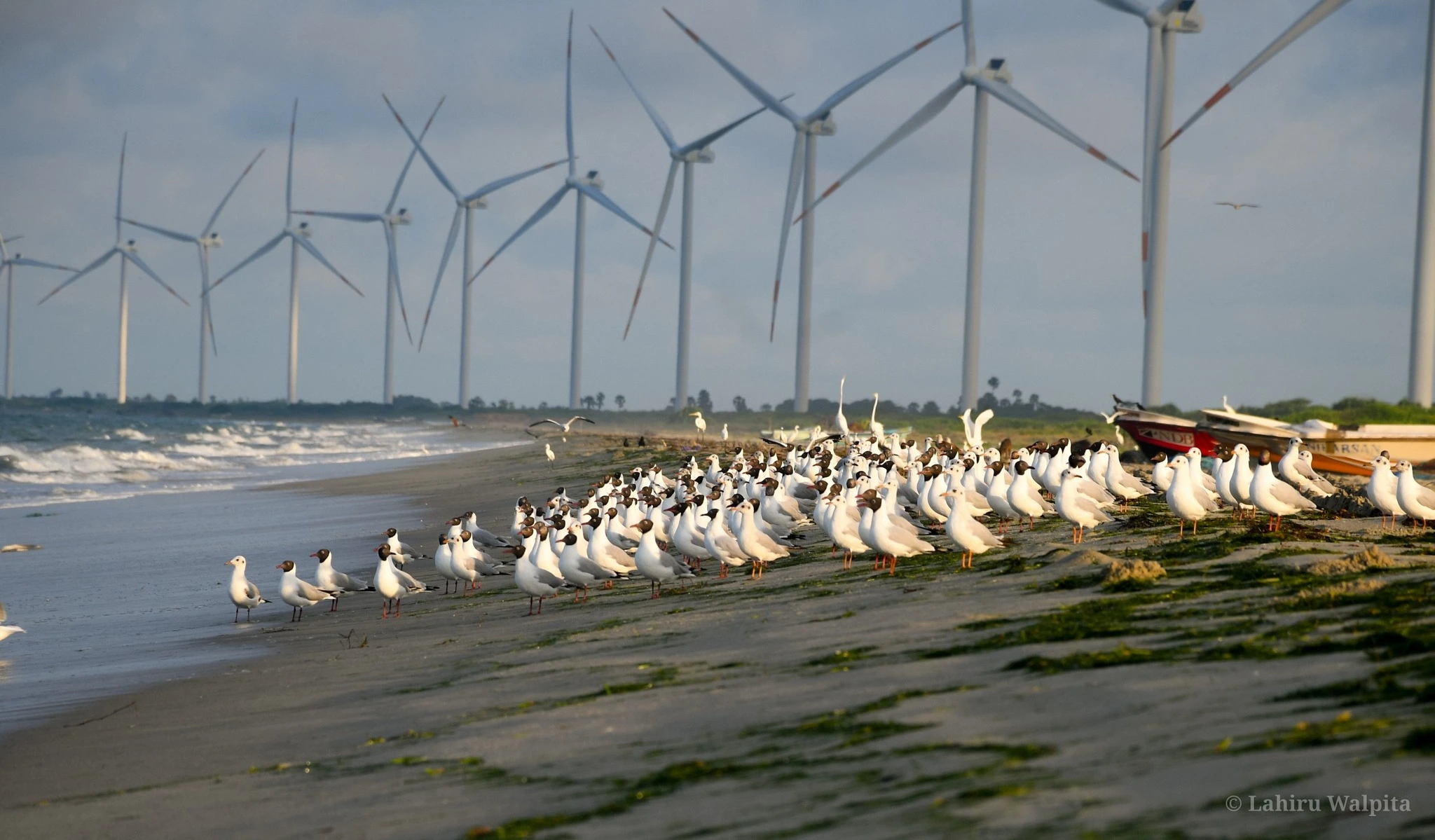Sri Lanka’s northern coast, especially the Mannar – Pooneryn belt, has long been hailed as one of South Asia’s best wind corridors. Studies by the Asian Development Bank and the Ceylon Electricity Board identified it as capable of powering nearly a quarter of the island’s electricity demand through clean energy. The winds are steady, the terrain ideal, and the need for renewable energy urgent.
So when the government signed a power-purchase agreement in May 2024 with India’s Adani Green Energy Ltd to build two large wind power plants totalling 484 megawatts, it seemed like a breakthrough. The projects promised investment worth nearly US $440 million, job creation, and much-needed relief from the burden of fossil-fuel imports. Yet, within a year, the deal was revoked and the projects stalled. What went wrong?
The deal that caught the wind
Under the 20-year agreement, Adani Green would supply wind energy to the national grid at 8.26 US cents per kilowatt hour. For a country struggling with energy shortages, the numbers looked attractive on paper. Mannar and Pooneryn were to host state-of-the-art turbines that could anchor Sri Lanka’s transition to renewables and reduce dependence on expensive thermal plants.
But as the ink dried, questions began to swirl around the process. Critics pointed out that the contract had not been offered through an open tender. Opposition parties, environmental groups, and energy experts voiced concerns about transparency and cost. The tariff, they argued, was significantly higher than comparable renewable projects elsewhere in the region.
A political and economic storm
When a new administration came to power in late 2024, the Adani deal became one of the first to face review. The Cabinet revoked the existing power-purchase agreement early in 2025, citing the need to renegotiate tariffs and ensure value for money. Officials hinted that a revised price closer to 6 cents per kilowatt hour would be fairer to consumers and state utilities already burdened by debt.
Meanwhile, reports from international regulators alleging corruption and governance issues involving Adani entities in other jurisdictions further complicated matters. Although the company denied wrongdoing, political optics in Colombo turned unfavourable. The government, eager to distance itself from controversy, opted to reassess the contract completely.
Adani’s withdrawal and local resistance
By February 2025, Adani Green Energy formally withdrew, calling the project “financially non-viable” under renegotiated terms. For many, the move confirmed that Sri Lanka’s attempt to push for lower tariffs had effectively ended the venture. But economic concerns were only half the story.
On the ground, communities in Mannar and Pooneryn had begun voicing their own worries. Fishermen feared restricted access to coastal areas. Farmers complained of land acquisition without adequate consultation. Environmentalists warned that the massive wind turbines could disrupt the flight paths of migratory birds that pass through the Mannar wetlands, one of Asia’s most important bird corridors.
These protests gained momentum, culminating in August 2025 when President Ranil Wickremesinghe ordered a temporary suspension of new wind projects in the area pending an environmental and social review.
The price of delay
Sri Lanka’s renewable ambitions remain ambitious: the government hopes to generate 70 percent of electricity from clean sources by 2030. But with large-scale projects delayed or cancelled, the timeline appears increasingly unrealistic.
Each year of delay keeps the country tied to costly fuel imports. The Ceylon Electricity Board still relies heavily on diesel and furnace oil, both volatile in price. Every megawatt of wind energy deferred translates to higher generation costs, potential power cuts, and added pressure on foreign exchange reserves.
Investors, too, are watching carefully. The revocation of a signed power-purchase agreement raises concerns about contract stability and political risk. Developers may demand higher premiums or avoid Sri Lanka altogether unless procurement rules are clarified and consistently applied.
Environmental balance or lost opportunity?
To some observers, the government’s pause is a chance to correct course. The Mannar region is not just windy; it is ecologically unique. Conservationists argue that the environmental assessment for the Adani project underestimated risks to biodiversity. Sri Lanka cannot afford another episode of short-term economic gain at long-term environmental cost.
For others, however, the suspension reflects indecision. Renewable energy growth requires predictability, yet Sri Lanka’s energy policy has swung between enthusiasm and caution. The challenge is to balance national energy security, fiscal prudence, and local consent all without losing momentum.
What comes next?
Energy analysts suggest three possible paths forward:
1. Re-tendering under transparent bidding. A fresh, open process could invite global and local firms to compete at realistic tariffs while restoring confidence in Sri Lanka’s renewable sector.
2. Smaller phased projects. Instead of mega-contracts, modular 50 – 100 MW projects could minimise ecological disruption and build local experience gradually.
3. Community participation. Benefit-sharing mechanisms such as land-lease payments, local hiring, and fishery compensation could turn local resistance into cooperation.
At the policy level, Sri Lanka must establish a clear renewable energy roadmap with consistent pricing, bankable contracts, and environmental standards that satisfy both investors and citizens.
Lessons for business and governance
The cancellation of the northern wind projects offers several takeaways for policymakers and investors alike:
• Transparency pays. Closed-door deals invite suspicion. Competitive tenders with published criteria will reduce political risk.
• Tariff realism matters. Projects priced above regional benchmarks are vulnerable to review. Aligning tariffs with global costs ensures durability.
• Local consent is non-negotiable. Development without community engagement leads to delays and reputational damage.
• Institutional continuity is key. Successive governments must honour existing contracts unless violations are proven. Policy instability deters investment.
Conclusion: Catching the wind again
The Mannar and Pooneryn wind projects were meant to symbolise a turning point proof that Sri Lanka could harness its natural endowments to build a cleaner, more resilient economy. Their cancellation instead exposes how fragile the country’s investment climate remains when politics, cost pressures, and environmental realities collide.
Yet, this is not the end of Sri Lanka’s wind story. If the government can relaunch the northern projects with greater transparency, fair tariffs, and community trust, the same winds that now seem wasted could once again power progress.





